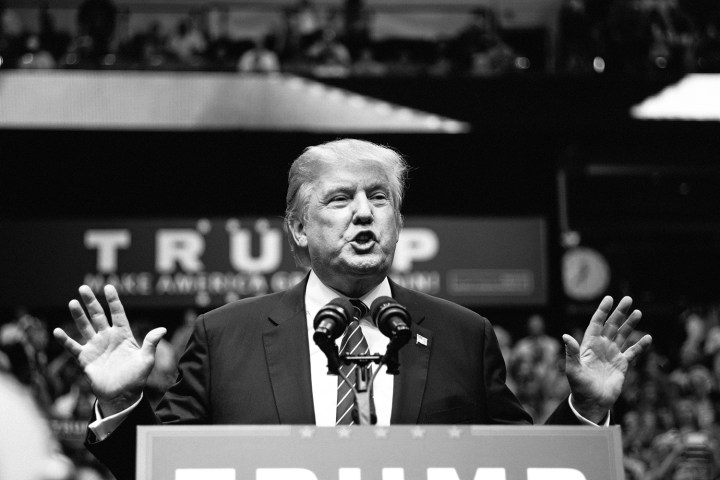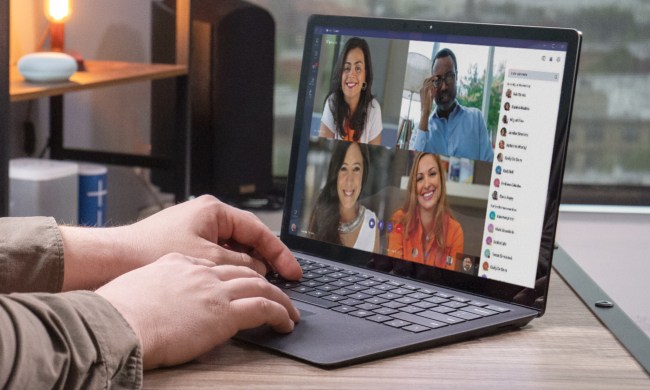
He suggested castration or the death penalty as the only appropriate remedy for the self-admittedly “pathological” Ben Carson. He claimed the U.S. plans to accept 250,000 Syrian refugees even though the Obama administration put that number at 10,000, citing “a pretty good source.” He insisted that in time, “I’ll be right,” as if the truth were some kind of interactive guessing game.
What reality TV did to network television, Trump is doing to network news.
There was no throughline; no coherence; no reality. Even the crowd standing behind him seemed bored and fidgety through the contradictory mash-up of paranoia, wishful thinking, opinion masquerading as fact, and dehumanizing insults. It looked like a campaign implosion. Instead, Trump’s poll ratings went up a couple of points after the speech.
That’s because he’s leveraging a medium that is also, largely, a mash-up of paranoia, wishful thinking, opinion masquerading as fact, and dehumanizing insults. Donald Trump is the ultimate Internet candidate, in not just style but substance. He owes his success to more than just his keen ability to leverage the political economy of a digitally disrupted media space. His rhetoric and positions — such as they are — are also consonant with the underlying biases of the digital-media environment.
More than shares and retweets
No, Trump is not a particularly adept Internet candidate — not in the sense that he is utilizing the organizing capability of the net. Join his campaign online and you get a simple thank-you email. Join Clinton’s or Sanders’ and you are offered the opportunity to notify your friends on social media, donate to the campaign, or attend meetings of volunteers in your neighborhood. There’s no great network of Trump Meetups or series of Reddit exchanges.
Yet Trump is an Internet spectacle nonetheless — a political Charlie Sheen who seems to know exactly how to ride the crest of trending topics, or even create them. On television, his speeches are incoherent mashups, without a clear story or theme. As clickbait, though, they are perfect: short, angry slogans, each more explosive than the last. With Sheen it was tiger blood and winning; with Trump, it’s Jersey City Jihadists and also, possibly, winning.
That’s because in a world where politics feel so fake and prepared, this verbal violence feels real. It’s an affront to the political correctness that has hemmed in expressions of rage at home, in the workplace, or in the media. When the only ones who are willing to say what certain people feel are the boys of gamergate or the trolls of comments sections, a Trump becomes a champion for turning subtext into text – for validating the dark thoughts others have but don’t see expressed.
As Clay Shirky would say, “Here comes everybody” – in the voice of a billionaire everyman. What reality TV did to network television, Trump is doing to network news. His clips are free entertainment, easy to show out of context, and the perfect content for eyebrow raising and pundit debate. The cable news networks in particular, already losing the race for scoops to the likes of Buzzfeed, have no choice but to spread his memes. The more sensational he gets, the more the cycle reinforces itself, like a pop star dominating Billboard charts.
‘The medium is the message’
But Trump isn’t just popular on the Internet alone. His success is less about the net than the digital-media environment in which we are all living. The Internet is the primary medium of our culture and has come to characterize the way we experience our world.
With Sheen it was tiger blood and winning; with Trump, it’s Jersey City Jihadists and also, possibly, winning.
This is what McLuhan meant when he told us “the medium is the message.” We may make our technologies, but once they are out in the open, they in turn shape us. Radio and television were part of the electric age of media. McLuhan saw how they led us to think of the world as one big connected place. Satellite television, live Olympics broadcasts, and moon landings were media of the boomer generation, and engendered a hands-around-the-globe, United Nations, internationalist drive in both business and politics. The Euro typifies that push toward one world.
Digital media, on the other hand, is all about choice and boundaries. We don’t have communities so much as affinity groups. We choose evermore specific sets of connections and feeds of information – and if we don’t, Facebook’s algorithms will do it for us. Your Google search is different than my Google search, because the company’s algorithms know how to parse what is different about our predilections.
The shift in political temperament from the electric era to the digital one has nothing really to do with right or left so much as a desire for boundaries. Ronald Reagan – the ultimate TV president — stood at the Brandenberg Gate and publically implored Michael Gorbachev to “tear down this wall.” Donald Trump, on the other hand, and true to the Internet culture’s bias for clearly defined boundaries, wants to build a wall between the U.S. and Mexico. Even the net’s tendency toward surveillance and privacy invasions are increasingly welcomed as a big-data barricade against ISIS – itself an amplification of this throwback to nationalist extremism.
I’m not praising or bashing Trump’s ideas. At least not here. My point is that they are more consonant in both tone and substance with the tone and substance of our digital media landscape. As theorists at the new “Center for the Study of Digital Life” like to remind us, where electric media was about shared, live visual experiences – McLuhan called it a hallucinatory medium – digital media is all about memory. Chips, hard drives, and the cloud, are all memory technologies.
No wonder Trump’s campaign is “Make America Great Again.” It’s a harkening back to a time that may not have existed, but an invoked memory nonetheless of that era before electronic media got us all mushy, and internationalist, and respectful of women, and non-judgmental of differences, and forgetful of our rightful place on the top of God’s hierarchy of nation states.
The first digigenic president
Think of it this way: Sanders is the radio candidate. He makes long-winded, passionate speeches about the rights of workers and the impoverished, and argues for the sorts of collectivist policies that quintessential radio president Franklin Delano Roosevelt offered America in the Depression. Hillary is the television candidate. Logical and schematic, she offers evidence and a plan for each and every national problem. If anything, she’s worked hard to lessen the appearance of fire in her belly, lest she come off as too threatening or screechy on the screen.
Your Google search is different than my Google search.
If Clinton is telegenic and Sanders is radiogenic, then The Donald is what we might call digigenic. His is not the radio voice of revolutionary passion nor the TV face of realistic resolve, but the Internet-friendly, pre-deconstructed string of shocking comments. Zingers, memes, gaffes, and un-facts, all receding into the same meaninglessness of yesterday’s news — no matter their degree of truthiness.
The spectacle of Trump provides a seemingly endless supply of what I once dubbed “social currency” – the kind of content we can use to get attention from others in a digital media landscape. He gives us all something to copy, paste, retweet, favorite, talk about, comment on, and publish. Even right here.







